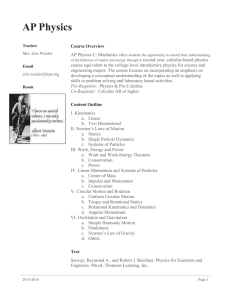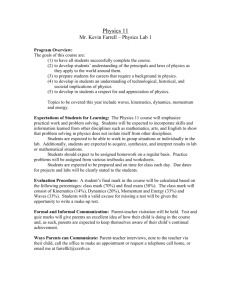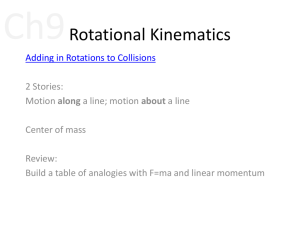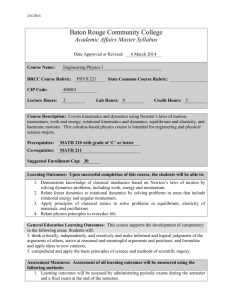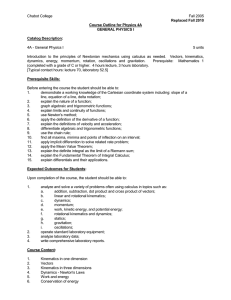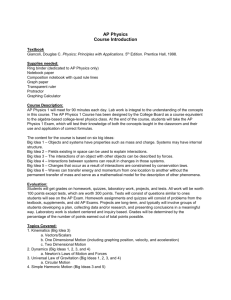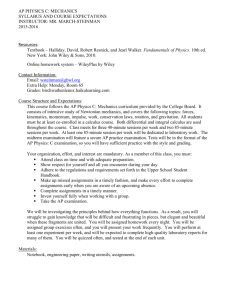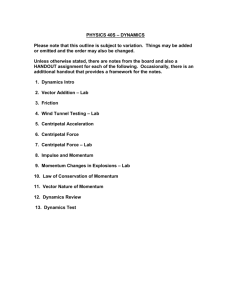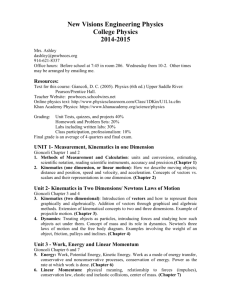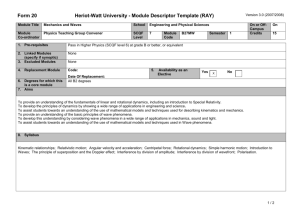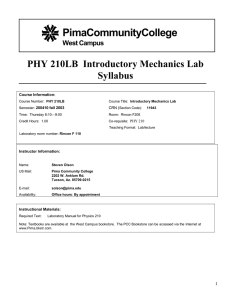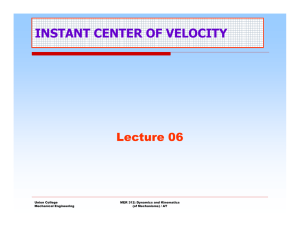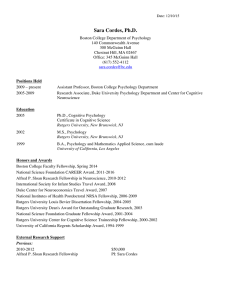COURSE SYLLABUS - Faculty Web Sites
advertisement
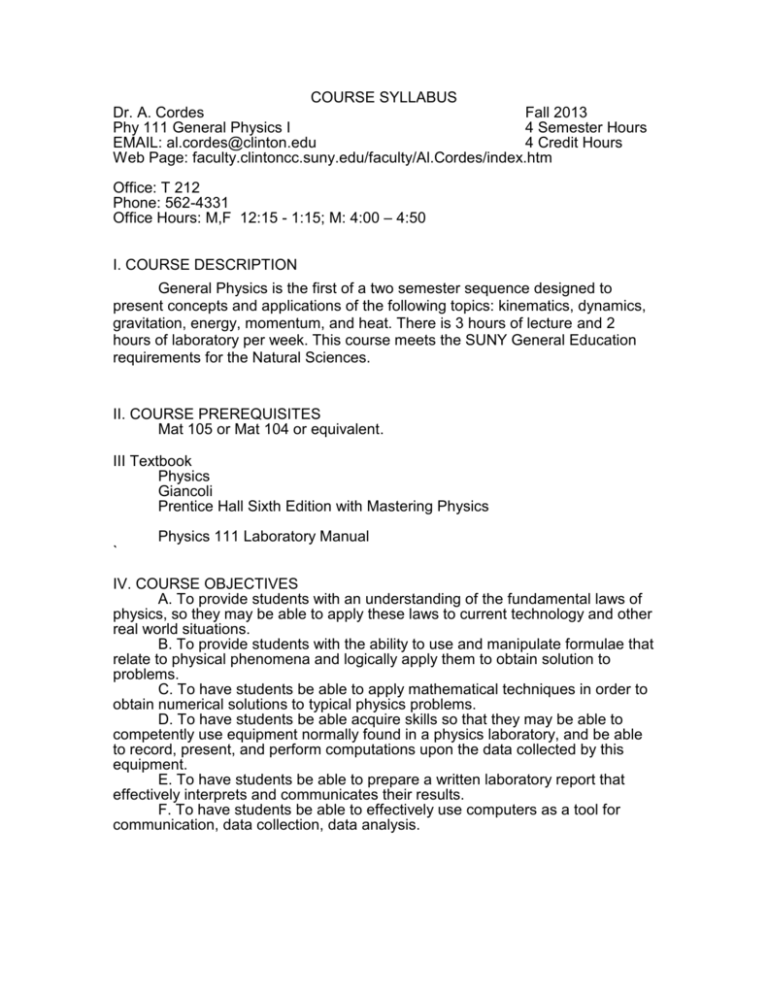
COURSE SYLLABUS Dr. A. Cordes Fall 2013 Phy 111 General Physics I 4 Semester Hours EMAIL: al.cordes@clinton.edu 4 Credit Hours Web Page: faculty.clintoncc.suny.edu/faculty/Al.Cordes/index.htm Office: T 212 Phone: 562-4331 Office Hours: M,F 12:15 - 1:15; M: 4:00 – 4:50 I. COURSE DESCRIPTION General Physics is the first of a two semester sequence designed to present concepts and applications of the following topics: kinematics, dynamics, gravitation, energy, momentum, and heat. There is 3 hours of lecture and 2 hours of laboratory per week. This course meets the SUNY General Education requirements for the Natural Sciences. II. COURSE PREREQUISITES Mat 105 or Mat 104 or equivalent. III Textbook Physics Giancoli Prentice Hall Sixth Edition with Mastering Physics Physics 111 Laboratory Manual ` IV. COURSE OBJECTIVES A. To provide students with an understanding of the fundamental laws of physics, so they may be able to apply these laws to current technology and other real world situations. B. To provide students with the ability to use and manipulate formulae that relate to physical phenomena and logically apply them to obtain solution to problems. C. To have students be able to apply mathematical techniques in order to obtain numerical solutions to typical physics problems. D. To have students be able acquire skills so that they may be able to competently use equipment normally found in a physics laboratory, and be able to record, present, and perform computations upon the data collected by this equipment. E. To have students be able to prepare a written laboratory report that effectively interprets and communicates their results. F. To have students be able to effectively use computers as a tool for communication, data collection, data analysis. SUNY General Education Knowledge Area Learning Outcomes: Students will demonstrate: A. Understanding of the methods scientists use to explore natural phenomena, including observation, hypothesis development, measurement and data collection, experimentation, evaluation of evidence, and employment of mathematical analysis; and B. Application of scientific data, concepts, and models in one of the natural sciences. V. COURSE ORGANIZATION AND METHODS A. Attendance Procedure: Students will be expected to attend all classes. Attendance will be taken at the beginning of each class. Excessive absences will be reported to the college administration. Makeup exams will only be given for exceptional reasons. Proof may be required as to why a student missed an exam. B. Methods of Instructions will include lectures, demonstrations and review of assignments given in previous classes. Many homework assignments will be given on the web based MASTERING PHYSICS. You will receive an access code when you purchase your textbook. You will also need to supply the course ID which is MPCORDESF13.I will also assign written homework which I will check periodically. C. Methods of Evaluation: Students will be evaluated according to the following: Howework and other Assignments Lab Notebooks laboratory reports; 4 exams given during the course of the semester. Grades will be computed according to the following formula: Homework Lab Reports Lab Notebooks Exam Average = 15% = 10% = 20% = 55% Grades will be assigned according to the following: 100 to 91 90 to 88 87-85 84-80 79-78 77-75 A AB+ B BC+ 74-70 69-68 67-65 64-60 Below 60 C CD+ D F D. Academic Honesty: All students are expected to be behave with academic honesty. It is not academically honest, for example, to misrepresent another person’s words or ideas as one’s own, to take credit for someone else’s work or ideas, to accept help on a test or to obtain advanced information or confidential test materials, or to act in a way that might harm another student’s chance for academic success. When the instructor believes that a student has failed to maintain academic honesty, he or she may given an “F”, either for the assignment or the course depending upon the severity of the offense. VI. COURSE OUTLINE 1. Introduction (Chapter 1) a) What is physics and how it relates to other fields b) Models and theories c) Orders of magnitude 2. Kinematics in one dimension (Chapter 2) a) Speed, velocity and displacement b) Frames of reference c) Acceleration and Accelerated Motion d) Free falling motion 3. Kinematics in two dimensions (Chapter 3) a) Adding vectors using graphical techniques b) Using analytical methods for adding vectors c) Projectile motion ----------------------Exam #1------------------------------4. Dynamics (Chapter 4) a) Force b) Newton's Laws of motion c) Weight d) Friction and Inclines 5. Circular Motion (Chapter 5) a) Kinematics of circular motion b) Dynamics of circular motion c) Gravitation d) Satellites and weightlessness e) Fundamental forces 6. Work and Energy (Chapter 6) a) Work b) Kinetic energy c) Potential energy d) Conservation of energy e) Power ----------------------Exam #2------------------------------ 7. Linear Momentum a) Momentum and Force b) Conservation of Momentum c) Collision and impulse d) Center of mass 8. Rotational Motion a) Angular quantities b) Kinematics for uniformly accelerated rotational motion c) Torque d) Rotational Dynamics e) Rotational Kinetic Energy f) Angular momentum 9. Bodies in Equilibrium a) Statics and equilibrium b) Statics problems ----------------------Exam #3-------------------------10. Temperature and kinetic energy a) Temperature b) Expansion c) The gas laws and Absolute temperature d) Kinetic theory 11. Heat a) Heat and Energy b) Specific Heat and Calorimetry c) Latent Heat of Fusion and Vaporization d) Heat Transfer 12. Vibrations and waves a) Simple Harmonic Motion b) The pendulum c) Resonance ---------------------Exam #4-----------------------VII. COURSE CONTINUITY PLAN: In the case that the college officially closes because of an emergency which causes a short term disruption of this course, we will utilize e-mail to continue this course in the short term (1-3 weeks). All students need to utilize their campus e-mail to receive course related information. VIII. COMPUTER/INTERNET USE: A CCC student should expect that any class may require some course activity that uses a computer and the internet. Activities could include but are not limited to accessing the course syllabus, schedule, or other handouts on a website, completing homework online, taking quizzes or submitting written work, participating in a discussion or sending/receiving email.
